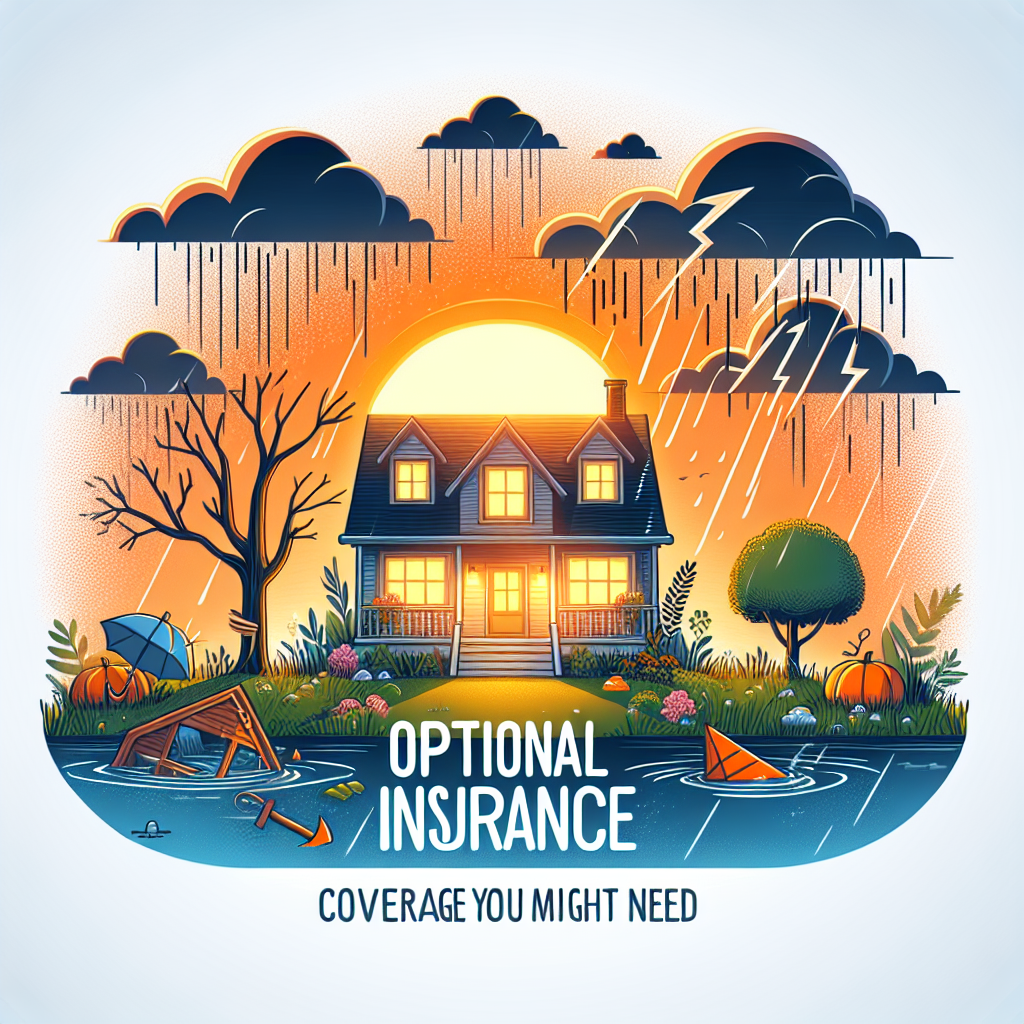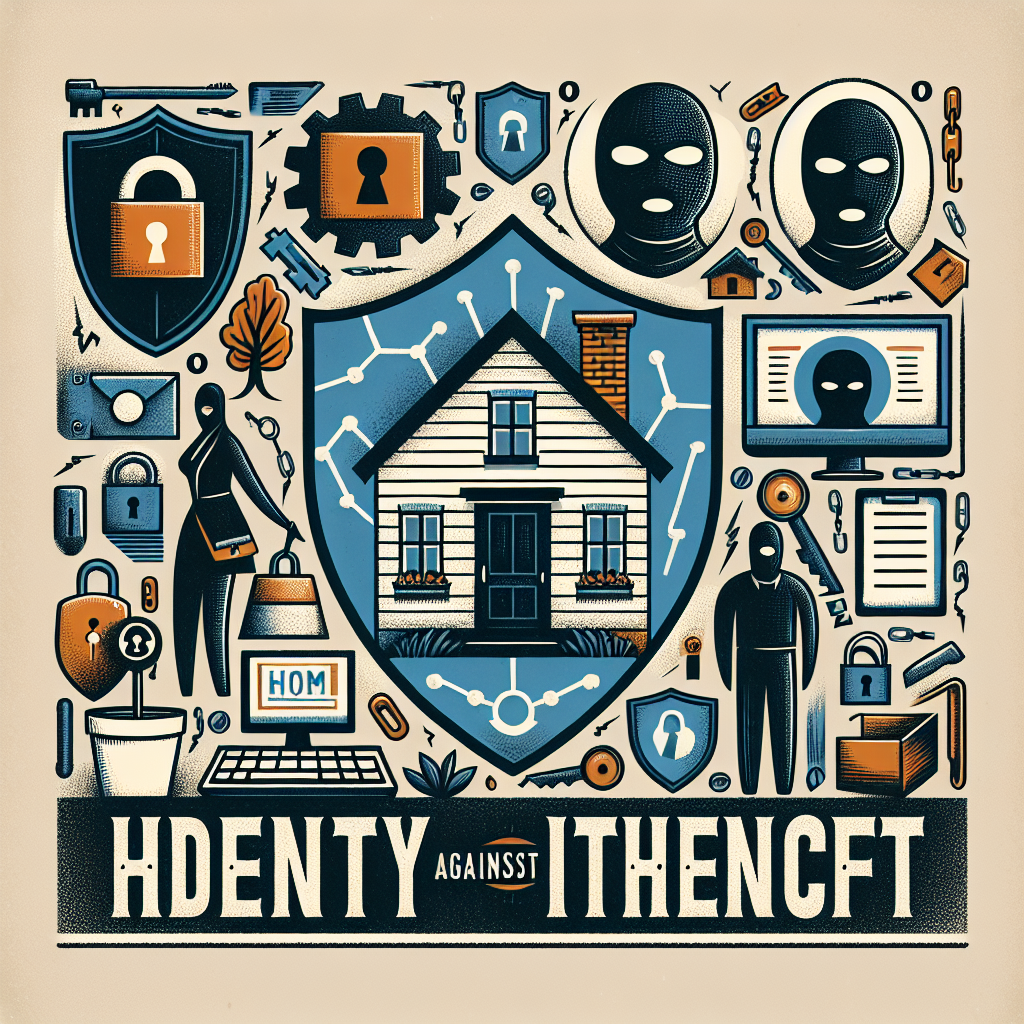Filed under Home Insurance on
Optional Home Insurance Coverage You Might Need

Insurance policies are built to handle the big, obvious risks. But the real stress often hides in the gaps you don’t see. That’s where Optional Home Insurance Coverage You Might Need can turn a budget-busting surprise into a manageable inconvenience. From aging utility lines under your yard to a sump pump that fails during a summer storm, optional endorsements and add-ons tailor a standard homeowners policy to your life, your location, and your home’s quirks.
Why optional coverages matter more than ever
Standard homeowners policies (like an HO-3) do a lot of heavy lifting—covering your home, your belongings, and liability. Still, they exclude common scenarios: flood, earthquake, water backup, equipment breakdown, code upgrades, and more. Losses tied to those gaps can be significant. FEMA notes that as little as one inch of water can cause roughly $25,000 in damage, and about a quarter of flood claims are filed outside designated high-risk zones. Meanwhile, the Insurance Information Institute has documented rising claim severity driven by inflation in construction materials, labor shortages, and more frequent severe weather events.
In other words, the risks are changing. Your policy should, too. Knowing which endorsements exist and how they apply is the first step to pinpoint the Optional Home Insurance Coverage You Might Need.
Water, weather, and the elements: plug the biggest holes
Water backup and sump overflow
What it covers: Damage when a drain, sewer, or sump pump backs up or overflows. Standard policies typically exclude this, leaving homeowners responsible for costly cleanup, mold remediation, and replacing flooring or furniture.
Why it matters: Plumbing or storm-related backups are among the most common water losses. Even a small backup can ripple into thousands in repairs and restoration.
Typical cost and limits: Often $50–$250 per year for limits ranging from $5,000 to $25,000 or more. Consider higher limits if you have finished basements, valuable contents, or a history of heavy rain events.
Service line coverage
What it covers: Buried utility lines on your property—water, sewer, electric, gas—that you own. Damage from root intrusion, deterioration, or freezing typically isn’t covered by a standard policy.
Why it matters: A collapsed sewer line can cost $3,000–$10,000+ to dig up and replace, not counting landscaping or driveway damage.
Typical cost and limits: Often $30–$70 per year for $10,000–$20,000 in coverage, with options for higher limits. Particularly valuable for older neighborhoods or tree-lined streets.
Flood insurance
What it covers: Flooding from rising water, storm surge, or rapid snowmelt—hazards excluded by most homeowners policies. You can buy through the National Flood Insurance Program (NFIP) or select private insurers.
Why it matters: FEMA reports that 99% of U.S. counties have experienced flooding since the late 1990s, and a significant share of claims occur outside “high-risk” zones. With heavier downpours becoming more common, flood risk is expanding beyond coastal areas.
Typical cost and limits: NFIP policies commonly run $500–$1,200 per year, depending on elevation, home characteristics, and flood zone, with structure coverage up to $250,000 and contents up to $100,000. Private insurers may offer higher limits and additional features. Flood coverage often tops the list of Optional Home Insurance Coverage You Might Need in many regions.
Earthquake insurance
What it covers: Damage from earth movement—earthquakes, aftershocks, and sometimes man-made seismic events. Standard home policies exclude earthquakes entirely.
Why it matters: The U.S. Geological Survey identifies meaningful seismic risk across multiple states, not just California. Older homes and those on soft soils can be especially vulnerable.
Typical cost and limits: Premiums vary widely by location and construction type; deductibles often range from 5–25% of the dwelling limit. Brace heavy furniture and water heaters, and consider retrofits for older homes; insurers may offer credits for mitigation measures.
Windstorm and hail enhancements
What it covers: In some coastal or hail-prone areas, standard policies include separate wind or named-storm deductibles, often a percentage of your dwelling limit. Endorsements may allow different deductibles, roof surface replacement cost, or matching materials coverage.
Why it matters: Roof replacement costs have soared. Without the right endorsements, you could be reimbursed at depreciated value or stuck with mismatched shingles or siding.
Typical cost and limits: Pricing is highly regional. Review whether your policy pays replacement cost for the roof and whether it provides “matching of undamaged siding” to avoid patchwork repairs.
Home systems and utility protections
Equipment breakdown coverage
What it covers: Mechanical, electrical, or pressure-system failures for items like HVAC units, boilers, appliances, smart home systems, and even heat pumps or EV chargers. This is different from wear and tear and goes beyond typical appliance warranties.
Why it matters: Power surge or compressor failure can result in sudden, expensive repairs. Equipment breakdown bundles multiple risks in one endorsement.
Typical cost and limits: Often $40–$100 per year with limits around $50,000 and a $500 deductible. Check sublimits for electronics and specialty systems.
Ordinance or law coverage (code upgrade)
What it covers: The increased cost to bring damaged portions of your home up to current building codes during a covered claim—think electrical, insulation, or structural changes required by inspectors.
Why it matters: Older homes face larger gaps between past and current codes. Without this, you pay the upgrade difference out of pocket.
Typical cost and limits: Often available at 10%, 25%, or 50% of dwelling coverage. The added cost is usually modest relative to the potential expense of upgrades.
Green rebuild or increased cost endorsement
What it covers: Upgrades to energy-efficient or eco-friendly materials during repairs after a covered loss, such as ENERGY STAR appliances or sustainable roofing.
Why it matters: If you plan to “build back better,” this endorsement can help bridge the cost difference.
Typical cost and limits: Usually a small premium add, with modest sublimits. Ask how it coordinates with ordinance or law coverage.
Personal property and lifestyle add-ons
Scheduled personal property
What it covers: Higher limits for specific valuables like jewelry, art, collectibles, or high-end electronics. Also broadens covered perils and can eliminate deductibles for listed items.
Why it matters: Standard policies cap certain categories—often $1,500 for jewelry theft, for example. Scheduling avoids painful shortfalls.
Typical cost and limits: Based on appraised value. You can schedule single items or collections; many insurers require recent appraisals for high-value pieces.
Cyber and identity theft protection
What it covers: Costs related to identity restoration, credit monitoring, cyber fraud, ransomware, or online shopping scams. Some policies extend to connected smart home devices.
Why it matters: As households add more connected tech, cyber events increase. Identity recovery assistance can save time and reduce losses.
Typical cost and limits: Often $25–$100 per year with varying sublimits for forensic IT services, data restoration, and lost funds.
Home-sharing or short-term rental endorsement
What it covers: Liability and property damage when you rent a room or your entire house on platforms like Airbnb or VRBO. Without an endorsement, rental activity can void coverage for related losses.
Why it matters: Even occasional rentals change your risk profile. Clarify what counts as “business use” under your policy.
Typical cost and limits: Depends on frequency and location; some carriers require a landlord or commercial policy for frequent rentals.
Food spoilage and utility interruption
What it covers: Replacement of spoiled food after a covered outage and sometimes damage caused by utility service interruptions.
Why it matters: After storms, extended outages can wipe out freezers and refrigerators. This endorsement is inexpensive and convenient.
Typical cost and limits: Often included at low limits; an endorsement can boost limits to $500–$2,500 or more.
Liability and legal protections
Personal umbrella policy
What it covers: Extra liability protection above your home and auto policies, typically starting at $1 million in limits. It kicks in when a claim exceeds your primary policy limits.
Why it matters: Lawsuits stemming from injuries on your property, dog bites, or accidents can exceed standard limits. Umbrellas are cost-effective ways to increase protection.
Typical cost and limits: Often $200–$500 per year for the first $1 million, with additional increments available.
Animal liability endorsement
What it covers: Liability for injuries caused by your pet. Some breeds or prior incidents may be excluded without an endorsement.
Why it matters: Medical and legal costs from dog bite claims can escalate quickly. Don’t assume your pet is covered automatically.
Typical cost and limits: Varies by breed, claims history, and state regulations.
Backyard liability considerations
What it covers: Clarifies coverage for pools, trampolines, and play structures. Some carriers require safety features like fencing or restrict use entirely.
Why it matters: Attractive nuisances elevate risk. The right combination of liability limits and safety measures can keep coverage affordable and effective.
Condo, townhome, and HOA-specific add-ons
Loss assessment coverage
What it covers: Your share of a special assessment from the condo or HOA master policy due to a covered loss—like a storm-damaged roof or legal settlement.
Why it matters: Standard condo policies offer minimal loss assessment coverage. Major assessments can run into five figures.
Typical cost and limits: Endorsements often increase limits to $50,000–$100,000. Ensure your endorsement covers the right perils and types of assessments.
Building items and improvements
What it covers: Upgrades inside your unit—cabinets, flooring, built-ins—that may not be fully covered by the master policy.
Why it matters: Determine whether your HOA policy is “all-in,” “bare walls,” or somewhere in between. Your personal coverage should fill the gaps.
Fine-tuning your policy: small endorsements with big impact
Extended or guaranteed replacement cost
What it covers: Additional coverage above your dwelling limit if major damage exceeds estimates due to inflation or demand surge after a catastrophe.
Why it matters: Construction costs can spike after regional events. An extra 25%–50% buffer can protect against underinsurance.
Matching of undamaged materials
What it covers: Ensures repairs extend to undamaged but contiguous areas so siding, roofing, or flooring matches throughout.
Why it matters: Without it, you may end up with a patchwork appearance despite using quality materials.
Inflation guard
What it covers: Automatically increases your dwelling and sometimes personal property limits during the policy term to keep pace with building cost inflation.
Why it matters: Reduces the risk of being underinsured as prices rise.
Foundation water seepage or mold/fungi endorsements
What it covers: Limited coverage for seepage or mold remediation when tied to a covered loss. Standard policies often cap or exclude these costs.
Why it matters: Mold can be expensive to remediate and is typically tightly limited without an endorsement.
Real-world example: a tale of two basements
Two neighbors remodeled their basements with similar finishes. After a storm, a municipal line backed up into both homes. The first homeowner had a $10,000 water backup endorsement, which covered cleanup, drying, antimicrobial treatment, and replacing damaged flooring, minus a modest deductible. The second homeowner’s base policy denied the claim because water backup wasn’t included. That family paid out of pocket and faced weeks of disruption waiting to save for repairs. The right endorsement turned a crisis into an inconvenience.
How to choose Optional Home Insurance Coverage You Might Need
- Map your hazards. Consider local perils: floodplains, hail corridors, wildfire zones, earthquake faults, and aging municipal infrastructure. Public sources like FEMA flood maps, your state insurance department, and local building officials can offer insights.
- Assess your home’s vulnerabilities. Age of roof and plumbing, type of foundation, presence of a sump pump, smart home systems, finished basement, and mature trees all influence risk.
- Review policy exclusions line by line. Make a list of what your base policy does not cover: flood, earth movement, backup, equipment breakdown, matching, and code upgrades often top the list.
- Right-size your deductibles. Higher deductibles can lower premiums, but ensure you can write the check at claim time. For wind or named storm deductibles expressed as a percentage, understand the dollar impact on a large loss.
- Set realistic limits. For endorsements like water backup, service line, and loss assessment, choose limits that reflect worst-case scenarios in your home and area.
- Consider claims service and documentation. Ask about carrier turnaround times, preferred vendors, and whether endorsements include specialized support (e.g., identity recovery teams or forensic IT for cyber).
- Leverage mitigation to earn credits. Impact-resistant roofing, whole-home surge protection, water leak sensors and automatic shutoff valves, seismic retrofits, and defensible space for wildfire can reduce risk and sometimes unlock discounts.
- Compare options annually. Building costs, climate patterns, and personal circumstances change. Revisit your endorsements each renewal.
Section-by-section guide to popular endorsements
- Water backup: Essential for finished basements and older sewer lines.
- Service line: Valuable in mature neighborhoods and cold climates.
- Flood: Consider regardless of zone if heavy rain events are increasing.
- Earthquake: Important in seismic regions or for older, unretrofitted homes.
- Equipment breakdown: Ideal for homes with HVAC, smart tech, or EV chargers.
- Ordinance or law: Crucial for homes older than 20–30 years.
- Scheduled property: Necessary for jewelry, art, collectibles, or expensive gear.
- Cyber/ID theft: Helpful for connected homes and active online households.
- Umbrella: A must for higher net worth, landlords, pool owners, or frequent hosts.
- Loss assessment (condo/HOA): Important where master policies have large deductibles.
Trends shaping Optional Home Insurance Coverage You Might Need
Wetter storms and growing flood exposure
Across many regions, heavier downpours are producing street flooding beyond recognized floodplains. That has driven more homeowners to consider private flood policies with flexible limits and additional living expense—features not available through the NFIP.
Hail, wind, and roof economics
Roofing costs have risen with materials and labor. Insurers increasingly use actual cash value for older roofs unless you add a replacement cost endorsement. Matching and cosmetic damage endorsements can determine whether you get a uniform, high-quality finish after a storm.
Smart homes, EVs, and electrical loads
Adoption of EV chargers, solar panels, and smart devices increases exposure to electrical and mechanical breakdowns. Equipment breakdown coverage has evolved to include these technologies and frequently offers green replacement options.
Building code evolution
Post-disaster updates to building codes can be substantial, especially for wind uplift, wildfire-resistant materials, and energy efficiency. Ordinance or law coverage has moved from “nice to have” to “must have” for many older structures.
Litigation and liability severity
Higher verdicts and medical costs make umbrella policies a cost-effective way to shield assets. If you host gatherings, have a pool, or own rental property, liability upgrades deserve a close look.
Expert tips from adjusters and risk professionals
- Document your home now. Keep cloud-based photos or video of rooms, serial numbers, and upgrades. It speeds claims and supports scheduled property values.
- Know your sublimits. Standard policies often cap theft of jewelry, firearms, cash, and business property at home. Scheduling or business endorsements close those gaps.
- Mind the basement. If you have living space below grade, prioritize water backup, leak sensors, and, if applicable, flood coverage.
- Coordinate with warranties. Manufacturer warranties and service contracts can overlap with equipment breakdown. Redundancy isn’t always bad, but you should know who pays first.
- Ask about special deductibles. Named storm and wind/hail deductibles can be separate—and large. Match them to your savings.
Common misconceptions to avoid
- “I’m not in a flood zone, so I don’t need flood insurance.” Many claims originate outside high-risk zones. Consider your local drainage, soil, and history of heavy rain.
- “My policy covers all water damage.” It likely excludes water backup, groundwater seepage, and flood unless endorsed or purchased separately.
- “Old pipes are insured if they break.” Gradual wear and tear is typically excluded. Service line coverage addresses sudden failures of buried lines but not routine maintenance.
- “If my neighbor’s tree falls, their insurance pays.” Generally, your policy covers your property unless negligence is proven. You still need adequate limits.
- “Matching finishes are guaranteed.” Not without a matching endorsement or favorable policy language.
A quick checklist to share with your agent
Before your next renewal, use this checklist to identify Optional Home Insurance Coverage You Might Need.
- Do I have a finished basement or valuable items stored below grade?
- Have I installed a sump pump, and does my policy include backup/overflow?
- How old are my sewer/water lines, and are they covered as service lines?
- Is my roof covered at replacement cost, and do I have matching coverage?
- What is my wind or named storm deductible in dollars, not percentages?
- If my home is older, what ordinance or law limit should I carry?
- Do I own high-value jewelry, art, or collectibles that need scheduling?
- Do I need cyber or ID theft coverage given my devices and online habits?
- Do I rent my home or a room on short-term rental platforms?
- If I live in a flood-prone or hail-prone area, what endorsements or separate policies fit?
- Am I comfortable with my liability limits, or should I add an umbrella?
What to ask about pricing and value
- Bundling: Can adding equipment breakdown, water backup, or umbrella unlock multi-policy discounts?
- Loss prevention credits: Do leak detectors, monitored alarms, or smart shutoff valves qualify for savings?
- Deductible optimization: What’s the premium difference between $5,000 and $10,000 named storm deductibles?
- Limit sweet spots: Where do $10,000 vs. $25,000 water backup limits land on the price curve?
- Claim support: Are there preferred contractors and service guarantees for endorsed coverages?
When to update endorsements
- After renovations: Finished basements, kitchen overhauls, or new roofs change both exposure and replacement cost needs.
- Before storm season: In coastal or hail-prone areas, some carriers restrict changes during active seasons.
- After new tech installs: EV chargers, solar panels, or whole-home battery systems may warrant equipment breakdown and electrical upgrades.
- Life events: Marriage, new valuables, home-based business activities, or welcoming a new pet can shift coverage needs.
Putting it all together
Start with a risk map of your home and neighborhood. Layer in your home’s age, systems, and finishes. Then compare that against your policy’s exclusions and sublimits. The goal is not to buy everything—it’s to buy smart. Small premium adds can protect against outsized risks, especially for water, wind, and liability.
Quick FAQs
Are endorsements transferable if I change insurers?
No. Each carrier structures endorsements differently. When you switch, recreate your protection with equivalent or improved options and confirm limits and deductibles.
Will endorsements raise my claim risk or premiums long term?
Endorsements don’t increase your chance of loss; they expand what’s covered. However, frequent claims can raise premiums. Pair coverage with mitigation—leak sensors, surge protection, and maintenance—to reduce claim frequency.
Is flood insurance required?
If you carry a mortgage in a FEMA-designated high-risk flood zone, your lender will likely require it. Otherwise it’s optional—but still worth evaluating based on local risk.
Do I need both equipment breakdown and extended warranties?
They can complement each other. Warranties often cover mechanical failure for specific items; equipment breakdown covers a wider range of sudden electrical and pressure-related failures across many systems. Review overlaps to avoid gaps.
What endorsements matter most for older homes?
Ordinance or law, water backup, service line, and matching materials typically deliver strong value. If in a seismic area, add earthquake coverage and consider retrofits.
Final thought: personalize your safety net
Insurance isn’t one-size-fits-all, and neither are endorsements. A modern policy should reflect your home’s age, systems, location, and the way you live. Use the insights above to have a focused conversation with your agent, identify Optional Home Insurance Coverage You Might Need, and fine-tune limits and deductibles that make sense for your budget.
Next steps
- Pull your current policy and list exclusions and sublimits.
- Note home features that increase risk: finished basement, older lines, smart tech, roof age.
- Get quotes for water backup, service line, equipment breakdown, ordinance or law, and any region-specific perils like flood or earthquake.
- Adjust deductibles to balance affordability with protection.
- Revisit annually as your home and local risk profile evolves.
The right mix of add-ons can transform a basic policy into a resilient plan. With a clear view of Optional Home Insurance Coverage You Might Need, you’ll be prepared for the headaches most homeowners never see coming—until they do.





